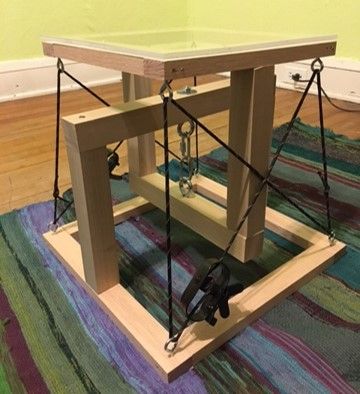Tensegrity Footstool
This didn't take too long to build, but it was fun and unique.
Tensegrity is a structural technique that relies on elements under tension for its integrity (hence the name). Tensegrity structures also have elements under compression, but their discontinuous arrangement gives a gravity-defying appearance to the whole. After seeing some examples going around of projects using this technique, I decided to give it a try myself.
The design I came up with was for a footstool (which could also be used as a small table for beverages in front of a couch). It comprises two wooden frames held together with a couple of chain links and some cord. There is a clear sheet of plexiglass for the top surface to make the structure as visible as possible. Here is a photo, which shows the way the upper frame appears to float:

The two frames use oak 1x2s for the flat part and poplar 2x2s for the columns and lintels; the flat part is sized to be a 1-ft square—on the inside dimensions for the base and the outside dimensions for the top. The column and lintel assemblies for the two frames had to be completed with the top and bottom stacked together (see photo below on the lower left) since they need to encompass each other. Eye hooks were installed at the corners of the flat part of each frame along with eye bolts in the centre of each lintel. The final step in the structural construction (adding the plexiglass top surface came later as a finishing step) was to add the elements under tension: the chain links at the heart of the footstool and the cords connecting corresponding corners on the top and bottom frames. The cords pass through tensioning ratchets (the kind intended for clotheslines) so they can be kept taut enough to provide stability. The following photos show various stages of the construction as it progressed:

Any tensegrity design like this needs to have a portion of the upper piece extend below part of the lower piece so that a tension element can impart an upward force to the upper piece. In this case, the central chain performs this function. Not only does it need to counteract the weight of the upper frame plus anything placed on top of it, it also needs to counteract the tension in the cords on the side, which all act to pull the two frame pieces together in order to provide stability. So the central tension element (the chain links, which are rated for 400 lbs.) hold the top piece up, and the other tension elements (the cord has a working capacity of 110 lbs., but the eye hooks are the limiting factor with a rating of 60 lbs., so the cord can only have about 30 lbs. of tension on it since each hook is pulled on by two segments of the cord (a more detailed analysis would account for the two segments of cord not pulling in quite the same direction)) provide stability. To wrap up the discussion of how forces are transmitted through the structure, the columns each carry (assuming even distribution) half the load in compression that the central chain does in tension.
Finally, here's a link that uses tensegrity as a mental model for geopolitics. To tie this whole post together, applying these concepts to Ottomans (either kind) is left as an exercise to the reader.